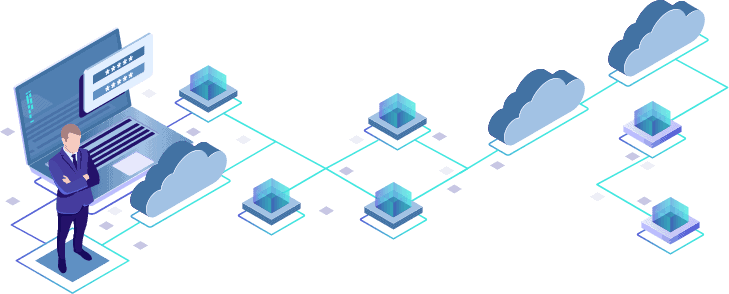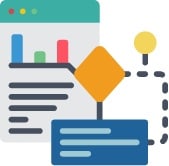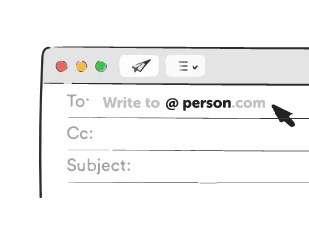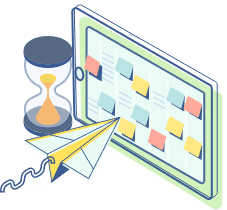Get 100 Views, 25 Credits & Free Monthly Recharge
Get 100 Views, 25 Credits & Free Monthly Recharge

The phrase says it all. Data is one of the most valuable resources, and it finds application nearly everywhere online. It is the virtual currency of the internet!
says it all. Data is one of the most valuable resources, and it finds application nearly everywhere online. It is the virtual currency of the internet!
But unlike oil, data isn’t a scarce resource. In fact, too much of it can be a bad thing. And just like oil, data is only valuable when it’s processed and refined. It isn’t of much use in its raw form. This is where database comes into the picture.
Databases are sets of compiled information that is structured and classified for future usage. They can be easily accessed and continuously updated. By organizing vast amounts of complex data, they make it much easier to use and to work with.
As the internet assumes more significance in our lives, so does data. This spells a break from the way things were always done.
In the past, marketing tended to appeal to the masses. Marketing efforts focused on creating content that would resonate with a majority of their target audience, hoping that a few would convert to paying customers.
But over the last decade, this has changed.

With big data, it’s possible to track and record nearly everything. This means that it’s possible to know who could be interested in your products, what they could be interested in, and where they live.
Using the data that your (to-be) customers provide, you can map out extensive profiles of them. In other words, customer segmentation is over. Each individual customer is his own segment. The focus has shifted from the popular to the personal.
If you are a digital marketer looking to generate more leads with big data, you have come to the right place.
Imagine that your company is developing an exciting gadget that is unique in the market. You are launching the product next week, and you have already started to spread the word.
How would you get maximum publicity?
What are your options?
One, of course, is to do it the traditional way. With the help of advertisements and billboards, you can broadcast your product in your locality. But that’s no crowd-puller. Another option would be to obtain a list of people in your neighborhood and directly mail them.
But, again, how effective is that going to be?
Many of the recipients will not show interest in your product. And, there might be a significant number of people who do show interest but don’t live in your area. It would be great if you could click a button to get a list of people in and around your area that are actually interested in your product.
That’s precisely what database marketing helps you do.
Database marketing is a new form of direct marketing. It collects and tracks customer data, such as names, contact details, addresses, and previous transactions. This information is then used to create a highly personalized experience for each customer.
The methods of data collection can vary.
Data is usually obtained from application forms, contest entry forms, subscriptions, and other legally compliant methods. Traditional marketing is dependent on the hope that at least some of its viewers respond positively.
Database marketing takes it to another level by seeking to understand what customers want, as well as how they receive your message.
These insights are then applied to fulfill the customer’s needs. In our previous example, your company could create a list of users who purchased similar products earlier.
They are the ones who are most likely to show interest in what you have to sell. Once built, these databases allow you to identify and get in touch with prospective leads.
Database marketing developed during the 1980s as an improvement on direct marketing.
Technology that could record customer responses gave way to a marketing philosophy that focused on two-way communication with the customer.

These changes were, in part, necessitated by an evolving business environment.
Direct marketing ceased to be as effective as it once was, as the customer became the center of all business operations.
The decline of traditional media also contributed to these developments. Now, marketers needed to find newer ways to reach their audience.
With technological advances, data was no longer stored in a physical form, but on computers.
This offered several advantages, such as accessibility, ease of usage, and security. These older databases paved the way for database marketing as we know it now.
As a result of today’s landscape, the modern customer expects a highly personalized experience with your brand.
To deliver this, marketers need to be aware of every point of the customer’s journey and engage them in a meaningful way.
They also need to know the customer’s tastes and preferences.
Database marketing makes this much easier than it would be otherwise.

You can deliver highly personalized messages to both leads and customers based on their preferences
Database marketing can help you figure out the best channel for your business to reach prospects

It makes it easy to recognize both first-time buyers and loyal customers. You can also segment customers based on demography, interests, and other relevant criteria
Database marketing quickly identifies prospects who are unlikely to respond, ensuring that you don’t waste time chasing cold leads.
By knowing your customers’ pain points, your support staff are better equipped to deal with their grievances

You can deliver highly personalized messages to both leads and customers based on their preferences

Database marketing can help you figure out the best channel for your business to reach prospects

It makes it easy to recognize both first-time buyers and loyal customers. You can also segment customers based on demography, interests, and other relevant criteria

Database marketing quickly identifies prospects who are unlikely to respond, ensuring that you don’t waste time chasing cold leads.

By knowing your customers’ pain points, your support staff are better equipped to deal with their grievances
Key Takeaway: Database marketing is a natural and much-needed improvement in direct marketing that is appropriate to the digital landscape. It is the groundwork for much of your marketing efforts.
To learn how to use database marketing for your business, continue reading…
Database marketing starts by collecting information about your prospects and customers so that you can understand them better.
This will help you to find out who your customers are, select your target markets, and tailor your messaging.
Here are the first few steps to getting starting with database marketing:


Buy your database from a reliable provider. A robust database can help you find your most valuable prospects. A reputable provider will be happy to provide small samples of their databases so that you can be confident that what you are about to invest in is the real deal.



Make use of every opportunity to collect and store customer data. Collect information from business cards, CTA sign-up forms, surveys, and transaction history. Record it in your database to give them a more personalized experience.


Data isn’t like wine or French cheese. With time, the likelihood that it will become redundant is almost inevitable. Make sure you always have the latest information about your prospects. Keep track of addresses, name changes, and any other information that might be relevant to your business.



Not every lead is a customer, and your database is likely to contain many inactive leads. Don’t hesitate to delete portions of your database if the information is no longer useful. Now that your database is set up, you can now begin to reap its advantages. Start with the following steps that are mentioned below:


Analyze your database and become familiar with your customers, their preferences, and purchase history. Start email and text message campaigns by sending out content that is relevant to them.



Follow up with your response rates, email open rates, and other analytics. If a customer shows interest in a product without buying it, make sure you follow up with an email and an incentive to buy it.


Customer lifetime value is a predictive marketing model that estimates what the lifetime relationship of a customer will be worth to your business. It identifies your most valuable customers as well as gives insights on what you can do to retain their business.



The need for businesses to track their customers’ behavior across channels is increasing. Analytical software can create information and instant reports that can help define your future business strategies.


As databases contain information about sales history, database marketing enables loyalty programs. This allows them to engage and reward long-time customers, which incentivizes them to choose your business.


You must have a well-planned database marketing strategy to make the most of it. These are steps you can take to ensure that happens:
Segment your target audience
Build an ideal customer profile for your product, and use it to decide what information is most important. Factors such as age, income, job position, and interests are relevant information for most businesses.
Update your data
Invest in CRM software that tracks and updates profiles when customers enter new information. Use online tools that protect against data decay. Safeguard your investment from power outages or technical glitches by investing in the right support software.
Gather customer data
Respect customer privacy
It is necessary to remember that your customers’ privacy is to be respected at all times. Personalization is all about providing the most relevant message to your target audience, not showing off about how much you know about them.
According to a report by Adestra, email marketing was the best marketing channel in terms of ROI.
68% of the companies that participated in the study rated email marketing as “good” or “excellent.”
As a cost-effective marketing technique, email marketing offers measurable results for businesses.
It keeps customers curious about new deals, ensures leads remain engaged and makes it easy to track your progress.
These are some ways in which database marketing can make your emails more effective:

With a database, you can track and record users who show a genuine interest in your product. Once you can reach out to them, you will find customers who are more than happy to endorse your brand.

With the help of customer data, you can send out personalized messages to your subscribers. Something as simple as addressing the reader by name can be very useful in boosting open rates. On average, regular emails generate $0.11 in revenue per mail, while personalization increases revenue by six times.
Segmenting your audience lists by industry, company size, and sales cycle. This ensures that customers receive only information that is most relevant to them. It also lends the element of personalization, which is essential to the modern customer. This, in turn, increases open and response rates, revenues and leads.


With the help of marketing automation software, you can send trigger-based emails. Trigger emails do much better than traditional emails in terms of open rates (95% higher), click-through rates (almost 2x), and conversions (40% more).
At any given time, a large portion of those you mail are going to keep your emails unopened. Find out those who are inactive and show little interest in your products. Then, you can redirect your efforts towards the leads that are most important to you, and spend less time chasing cold leads.

Key Takeaway: In terms of ROI and reach, email marketing trumps all other channels, including social media. When you add a clean and reliable database to the mix, it becomes an even more effective channel.
When done right, email marketing with the help of a database will provide your business with the vital boost it needs.
Now that you have your database and your email lists, it can be tempting to believe that your work is cut out.
In case you do, we have bad news.
There are several reasons why this happens. Your contacts addresses could have changed, they could opt-out of your email list, or their contact email addresses might simply be inactive.
Whatever the reason, it’s necessary to ensure that you’re always updating your database.
Here are some ways by which you can grow your email list to make the most of your database marketing efforts:
If you want people to remain subscribers, your emails must intrigue them. Ensure that your emails have a touch of personalization and creativity. If you are unique and engaging enough, your subscribers will look forward to your emails.


Use various types of email subscriptions to send targeted content. Email recipients are likelier to click on emails that cater to their specific interests. If you create multiple subscription types, you increase the chances that your contacts will subscribe to at least one of them.
To a website visitor, gated content may not be worth exchanging their details for. To lure them into sharing their information, you need to give them freebies first. Blogs that offer beginner advice on a relevant subject is an excellent way to start.


Use your social media account to host an online contest. This is incredibly helpful in generating a buzz and interest in your product. Encourage participants to sign up for it using their email address.
While it seems like a reasonable thing to do, asking for too much information can drive visitors away! By reducing the length of your forms and asking for only relevant information, you will convert more visitors. Besides, you can always ask for more information once you’re able to confirm their interest.


There are plenty of reasons why you should blog if you already haven’t! The most important one is that blogs can boost your search engine rankings, making you more visible online. It allows you to collect more subscribers and also establishes your authority as an expert on your subject.
Key Takeaway: Don’t believe that your email list will be as useful in the future as it is today. There are plenty of reasons why email list attrition happens, and there’s little you can do about it. Continually growing your email list with the tips mentioned above will keep your databases healthy and updated. You will also have access to the most recent information about your contacts.
It’s easy to find sources that proclaim email marketing is dead. With the advent of social media, emails were forecasted to take a backseat and slowly but inevitably fade away.
But nothing could be further from the truth.
Email still continues to rule the roost.
Segmentation is part of the reason why email marketing continues to remain on top.
Segmented campaigns receive up to 65% more clicks than non-segmented campaigns.
That said, figuring out the best tactics to segment your email list by can be challenging.
Here are some segmentation strategies you can implement for optimal results:
Information such as age, gender, position, and income reveals a lot about one’s interests and needs. The more information you can capture, the better.
However, make sure you don’t ask for too much, as it can scare prospects away from signing up.
Decide what information is most important to your business, and include it in the signup process.


A survey or quiz gives you an excellent opportunity to access valuable information. They can provide insights into individual tastes, preferences, and beliefs.
Provide users with an incentive in exchange for completing your surveys.
If you opt for a quiz, analyze the results carefully to learn more about your audience.
You can segment users based on open and click-through rates.
Designate users as either ‘active’ or ‘non-active’ based on their engagement with your emails.
You can focus on active users and target them more accurately. You can also launch programs to reward their loyalty.
Additionally, run specialized campaigns that aim to re-engage inactive subscribers.


A user’s previous purchases can reveal a lot about what they’re likely to buy from you later.
Start by sending emails of recommendation to buy products that are similar or would go down well with their previous purchase.
A prospect at the top of your sales funnel should be receiving different emails from those at the bottom.
For a set of brand-new or unique subscribers, send out generalized emails giving an overview of your products and services.
If they have been subscribers for a while, determine what their interests are. Then, send more targeted emails out for that product/service.

Key Takeaway: Segmentation is part of the reason why email marketing is and will continue to stay on top. With the help of the segmentation, you will understand your subscribers’ preferences. You can target your audience based on their needs and pain points. With a database and some creativity, segmentation can help you go a long way!
Email open rates are one of the most critical metrics for database marketers. It gauges the health of your email marketing campaigns. Low email open rates can mean your emails aren’t as useful as they can be.
There are plenty of mistakes that can occur during an email marketing campaign. This can result in a decline in click-through rates and lower profit margins.
Here are some tips to keep your customers clicking your emails:
Your subject line is the first thing your customer sees when they get an email.
Use A/B testing if necessary to figure out the right subject line for your emails.
Aim to be casual, personal, and interactive. And of course, test until you find the perfect lines!


An email is much likelier to get opened if it’s written directly to the receiver.
Ensure you use the recipient’s first name in your opening.
Make sure you frame your message as if they are the only recipients of the email.
This lends a sense of familiarity and will encourage your readers to keep opening your emails.
If customers associate your business with exciting and engaging emails, your open rates will undoubtedly skyrocket! Make sure you send them unique content that they won’t find elsewhere.


An essential factor that determines higher open-rates is familiarity.
If a user knows the person sending the email, it’s much likelier to get clicked.
However, if they realize it’s a company, chances are they will mark you as spam.
Emails that seem like they’re written by a real person at your organization is more personal and is likelier to get opened.
Timing is everything when it comes to digital marketing – regardless of channel.
Ensure you’re sending emails at the right time – you can find this out by researching your industry and audience.


Review and remove inactive subscribers from your email lists from time to time. Gloss over your list every now and then, and correct any glaring errors such as “@gmal.com.” This will improve your open rates as well as cut costs as it ensures you don’t pay for subscribers you can’t reach.
Key Takeaway: It’s hard enough to acquire your own email database. But what’s harder is convincing your prospects to click on your emails. That said, it is certainly doable as long as you don’t overlook a few simple details. It’s okay to be creative and personal when it comes to emails, but always remember to be professional.
Email marketing has a unique spot in the content marketing world and not without reason. It is practical, personal, and accessible, both for companies and the people they’re trying to reach.
But writing for email campaigns is no piece of cake. If your content is good, it’ll get clicks, but to really shine, you have to stand out.
Here are five points to keep in mind while writing content for your email campaigns:

Writing engaging content is a skill, but it’s more important to be clear about what you’re saying. Make sure your emails are precise and descriptive first, catchy, and attractive second.
This ensures that they will understand the purpose of your emails. They will also cement your authority as a company, and give your customers realistic expectations.
When it comes to email, the second person is the best voice you can use. By reaching and speaking out to your customers directly, it becomes easier for them to relate to your content.
This makes it likelier that they will connect with your emails. It also increases the odds of them opening your emails in the future.


Ensure that you showcase the benefits of your product, rather than the features. Although most marketers use features in their attempts to sell a product, focusing on benefits will give you a real edge over your competition. It paints a realistic picture of your product and sets the foundation for what can be expected.
Many marketers are guilty of being overly verbose and beating around the bush. This is one of the biggest turn-offs for any recipient.
It is necessary to be as brief and to the point as possible.
This increases the chances that your audience will remain interested in your content. It also keeps you on track and makes you relevant for the duration of your email campaign.


One doesn’t need statistics to underline this fact, for almost all of us have received spam emails. If you don’t like them, remain assured that your customers won’t either.
Only send out emails when you have to share relevant information. Timing is of paramount importance. Don’t rush or spam prospects needlessly, because it’s a surefire way to drive them away.
Key Takeaway: It’s easy to write content but challenging to create content that stands out.
It’s a maxim that applies for email marketing as well, just as much as other channels. But writing for emails isn’t rocket science.
With a little care, and effort, you can write unique, top-notch emails that will definitely provide a boost to your business and make you stand out.
We’ve talked about just how vital databases are to a great email marketing campaign.
Without one, you’re unlikely to find the leads you want to reach out to.
But did you know that databases can go beyond email marketing?
There are several channels you can use to promote your business.
It can take time to identify the best possible fit for you.
Multi-channel marketing allows your business to engage with various types of customers, tailor messages to groups, and maintain a consistent brand image.
Here are some ways you can make the most of multichannel marketing with databases:

Tracking your data is the best way to measure the impact you are making. Track data at the lowest possible level to ensure it is clear.
You should also consider how this data is stored. You need to have an efficient storage system to keep the data safe. In case nothing else is feasible, outsourcing is a viable option.
Once you track your data, it’s crucial for you to make sense of it. Once you identify your most valuable customers, develop a message that will drive them towards your business.
Ensure your message is consistent across channels.
Data analysis can help you understand changes you can make, as well as what you can do to boost the process. It also gives you a thorough understanding of your customers.


Following data analysis, you will understand the most effective channel for your business. Understand your customer’s needs, desires, and reality before mapping out your strategy.
Make sure your customer’s journey across all channels is a seamless one.
Map out your goals and stay aware of the essential trends in your market.
Create a clear and compelling message that remains consistent across channels. Ensure your messages are consistent with the identity of your brand.
Create your content, keeping in mind the different platforms customers will view it through. To establish a successful campaign, it’s crucial that your marketing and advertising teams are on the same page.


If you think you can tweak certain aspects or elements of your campaign, do so!
Tinker with different conversion variables and see if results change each time. Be flexible and open to new ideas while testing.
It is necessary to be adaptable and to know what to expect in an ever-evolving industry.
It helps you to track what works, what doesn’t, and what it takes to stay ahead of the pack.
Key Takeaway: Multi-channel marketing is all about getting your money’s worth. With the help of big data, your business can indeed take off on multiple channels. Remain proactive and aware of all the significant changes happening in your industry. An acute awareness of your data will help you respond to challenges, grow your business, and to remain successful.
These tools should have vital features that promote personalization. It should also make it easy to measure campaigns, have lead scoring, email broadcast, and other features.
They are the final yet fundamental addition to your arsenal.
Here are some database marketing tools you can use for your business. Each has several advantages over the other, so ensure you choose the right fit for your business –

is one of the most popular CRM systems online today, and for a good reason. It comes with features optimized for three areas of expertise: Sales, Marketing, and Customer Service.

is a marketing automation platform that stores customer and prospect information.
It is a highly data-driven and functional platform.
For example, it records and monitors your prospects’ activity even after they click a link.
This is a feature that most automation platforms do not offer.
It also tracks information such as most effective emails, website views, pages viewed and time, and day of the visit.
Pricing: Plans can vary from Basic ($2000/month) to Standard ($4000/month)

is the complete all-round package that you’re looking for.
It provides data and email services while doubling as a display advertising firm.
It is a viable option for marketers who are unwilling to build a database from scratch.
Stirista’s unique features include a proprietary segmentation software.
This dramatically helps clients in designing their ICPs.
It also has competitive conquesting capabilities, which help you to target your competition’s followers.
Stirista provides the most comprehensive list of unique features available to you, apart from the standard ones.
Pricing: Plans can vary from starter ($40/month) to custom (price depending on your objectives)

is a B2B marketing platform that focuses on sales-ready leads. This helps to send them personalized emails to leads while scoring them based on engagement.
Market provides a variety of options for marketers.
From customization options to Salesforce integration, it also has analytics tools to help you track how your data is doing.
Pricing: No set pricing, you will need to place the request for a quote.
is the B2B marketing automation and CRM software.
With access to nearly 73+ million contacts and 50+ million companies, it has one of the most comprehensive databases available.
ReachStream also provides marketing services, such as automation and Customer Relationship Management (CRM). From novice marketers looking to make their mark to experts trying to boost their business, ReachStream has several plans that can be tailored as per the requirements of your business.
Pricing: Plans start at $99/month. For more details, visit our pricing page or simply start with your Free Trial .
Key Takeaway: The foundation of any of your database marketing efforts lie with a robust database.
Data is the virtual currency of the internet. But like real money, to make the most of it, you need to know how use it wisely.
With so much data available today, it can be a real challenge to identify the data you need most.
The successful modern marketer is one who can manage his data most efficiently.
Managing vast amounts of data can seem daunting. But, with the right strategies and tools, it’s a much easier task than it seems.
It’s imperative that you have access to the best databases.
A good database can take time to build, or find, but at the finish line it will prove to be totally worth the resources and then some, you invested to acquire it.
With the right databases, your email marketing campaign will really take-off as you will be able to connect and convert with authentic leads and contacts.
You can also run marketing campaigns across multiple platforms and keep track of how each one of them are performing.
And, by investing in the right tools, you’ll find that you don’t need to devote as much time keeping real-time tabs.
The best tools do most of the number-crunching work for you, ensuring that you will be able to focus on what’s important.
Data by itself is of little significance. But when refined and processed, it’s a priceless resource.
We hope this guide proves to be a valuable nugget of knowledge that will help you run your campaigns to its fullest potential.

Author

Enrich your acumen with the latest research, think-pieces,
expert insights, and more.
